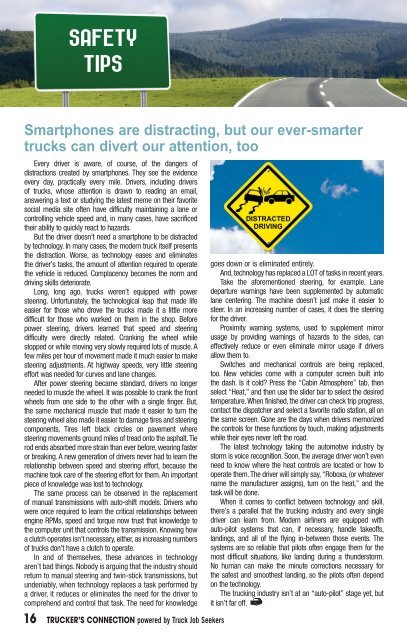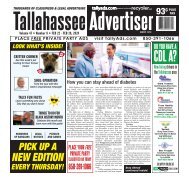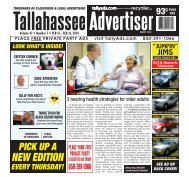TC0619
You also want an ePaper? Increase the reach of your titles
YUMPU automatically turns print PDFs into web optimized ePapers that Google loves.
SAFETY<br />
TIPS<br />
Smartphones are distracting, but our ever-smarter<br />
trucks can divert our attention, too<br />
Every driver is aware, of course, of the dangers of<br />
distractions created by smartphones. They see the evidence<br />
every day, practically every mile. Drivers, including drivers<br />
of trucks, whose attention is drawn to reading an email,<br />
answering a text or studying the latest meme on their favorite<br />
social media site often have difficulty maintaining a lane or<br />
controlling vehicle speed and, in many cases, have sacrificed<br />
their ability to quickly react to hazards.<br />
But the driver doesn’t need a smartphone to be distracted<br />
by technology. In many cases, the modern truck itself presents<br />
the distraction. Worse, as technology eases and eliminates<br />
the driver’s tasks, the amount of attention required to operate goes down or is eliminated entirely.<br />
the vehicle is reduced. Complacency becomes the norm and And, technology has replaced a LOT of tasks in recent years.<br />
driving skills deteriorate.<br />
Take the aforementioned steering, for example. Lane<br />
Long, long ago, trucks weren’t equipped with power departure warnings have been supplemented by automatic<br />
steering. Unfortunately, the technological leap that made life lane centering. The machine doesn’t just make it easier to<br />
easier for those who drove the trucks made it a little more steer. In an increasing number of cases, it does the steering<br />
difficult for those who worked on them in the shop. Before for the driver.<br />
power steering, drivers learned that speed and steering Proximity warning systems, used to supplement mirror<br />
difficulty were directly related. Cranking the wheel while usage by providing warnings of hazards to the sides, can<br />
stopped or while moving very slowly required lots of muscle. A effectively reduce or even eliminate mirror usage if drivers<br />
few miles per hour of movement made it much easier to make allow them to.<br />
steering adjustments. At highway speeds, very little steering Switches and mechanical controls are being replaced,<br />
effort was needed for curves and lane changes.<br />
too. New vehicles come with a computer screen built into<br />
After power steering became standard, drivers no longer the dash. Is it cold? Press the “Cabin Atmosphere” tab, then<br />
needed to muscle the wheel. It was possible to crank the front select “Heat,” and then use the slider bar to select the desired<br />
wheels from one side to the other with a single finger. But, temperature. When finished, the driver can check trip progress,<br />
the same mechanical muscle that made it easier to turn the contact the dispatcher and select a favorite radio station, all on<br />
steering wheel also made it easier to damage tires and steering the same screen. Gone are the days when drivers memorized<br />
components. Tires left black circles on pavement where the controls for these functions by touch, making adjustments<br />
steering movements ground miles of tread onto the asphalt. Tie while their eyes never left the road.<br />
rod ends absorbed more strain than ever before, wearing faster The latest technology taking the automotive industry by<br />
or breaking. A new generation of drivers never had to learn the storm is voice recognition. Soon, the average driver won’t even<br />
relationship between speed and steering effort, because the need to know where the heat controls are located or how to<br />
machine took care of the steering effort for them. An important operate them. The driver will simply say, “Roboxa, (or whatever<br />
piece of knowledge was lost to technology.<br />
name the manufacturer assigns), turn on the heat,” and the<br />
The same process can be observed in the replacement task will be done.<br />
of manual transmissions with auto-shift models. Drivers who When it comes to conflict between technology and skill,<br />
were once required to learn the critical relationships between there’s a parallel that the trucking industry and every single<br />
engine RPMs, speed and torque now trust that knowledge to driver can learn from. Modern airliners are equipped with<br />
the computer unit that controls the transmission. Knowing how auto-pilot systems that can, if necessary, handle takeoffs,<br />
a clutch operates isn’t necessary, either, as increasing numbers landings, and all of the flying in-between those events. The<br />
of trucks don’t have a clutch to operate.<br />
systems are so reliable that pilots often engage them for the<br />
In and of themselves, these advances in technology most difficult situations, like landing during a thunderstorm.<br />
aren’t bad things. Nobody is arguing that the industry should No human can make the minute corrections necessary for<br />
return to manual steering and twin-stick transmissions, but the safest and smoothest landing, so the pilots often depend<br />
undeniably, when technology replaces a task performed by on the technology.<br />
a driver, it reduces or eliminates the need for the driver to The trucking industry isn’t at an “auto-pilot” stage yet, but<br />
comprehend and control that task. The need for knowledge it isn’t far off.<br />
16 TRUCKER’S CONNECTION powered by Truck Job Seekers

















